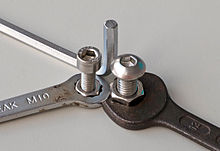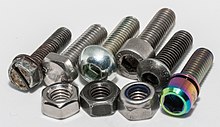Metric ISO thread
The metric ISO thread is a globally standardized thread with metric dimensions and a 60 ° flank angle . It replaces the slightly different older metric threads, but above all most threads with inch dimensions (of the few inch threads still used, the best known is the Whitworth thread with a 55 ° flank angle).
All of these threads occur as a pairing with screw and nut and are popularly also called machine threads or metal threads , even if one or both partners are made of plastic. This separates them from sheet metal , universal , quick assembly (for fastening plasterboard to battens or sheet metal profiles ) and wood screws , all of which cut their threads when they are screwed in for the first time.
standardization
The threads were in the ISO 1502 1996 "ISO general-purpose metric screw threads - Gauges and gauging" (DIN: ISO metric threads general purpose - teaching and gauging ) and has been in the DIN standards be detailed DIN 13 and DIN 14 .
- DIN 13-1 deals with standard threads with an outside diameter of 1 to 68 mm
- DIN 13-2 ff. Deals with the fine threads of the metric ISO threads
- DIN 13-14 ff. Deals with basic dimensions, tolerances , limit dimensions, gauges etc. for various threads (such as multi-start or bolt threads ) and nuts
- DIN 14 1–4 deals with threads with a nominal diameter of less than 1 mm
See DIN list of standards for an overview of rows 13 and 14
The standard requires that the curves must merge continuously (tangentially) into the flanks. This requirement is fulfilled for the internal thread of the nut with a circular rounding with radius t / 12. However, the standard does not require any particular form of rounding. The standard recommends a circular core fillet of the screw with a radius t / 6, but also allows other curves here.
Standard thread for general use (DIN 13-1)
| Outside-⌀ ( nominal-ø ) |
pitch |
Core ⌀ | Stress cross-sectional area |
Drill ⌀ for core hole |
Key-width | Through hole -⌀ according to EN 20273 | |||||
|---|---|---|---|---|---|---|---|---|---|---|---|
| External thread ( screw ) |
Internal thread ( nut ) |
Hexagon screw |
Hexagon socket - | fine (H12) |
medium (H13) |
coarse (H14) |
|||||
| Cylinder screw |
Countersunk screw |
||||||||||
| d = D | P | d 3 | D 1 | S. | s | d h | |||||
| mm | mm | mm | mm | mm 2 | mm | mm | mm | mm | mm | mm | mm |
| M 1 | 0.25 | 0.69 | 0.73 | 0.46 | 0.75 | 1.1 | 1.2 | 1.3 | |||
| M 1.2 | 0.25 | 0.89 | 0.93 | 0.73 | 0.95 | 1.3 | 1.4 | 1.5 | |||
| M 1.6 | 0.35 | 1.17 | 1.22 | 1.27 | 1.25 | 3.2 | 1.7 | 1.8 | 2 | ||
| M 2 | 0.4 | 1.51 | 1.57 | 2.07 | 1.6 | 4th | 1.5 | 2.2 | 2.4 | 2.6 | |
| M 2.5 | 0.45 | 1.95 | 2.01 | 3.39 | 2.05 | 5 | 2 | 2.7 | 2.9 | 3.1 | |
| M 3 | 0.5 | 2.39 | 2.46 | 5.03 | 2.5 | 5.5 | 2.5 | 2 | 3.2 | 3.4 | 3.6 |
| M 4 | 0.7 | 3.14 | 3.24 | 8.78 | 3.3 | 7th | 3 | 2.5 | 4.3 | 4.5 | 4.8 |
| M 5 | 0.8 | 4.02 | 4.13 | 14.2 | 4.2 | 8th | 4 (5) | 3 | 5.3 | 5.5 | 5.8 |
| M 6 | 1 | 4.77 | 4.92 | 20.1 | 5 | 10 ( 8) | 5 | 4th | 6.4 | 6.6 | 7th |
| M 8 | 1.25 | 6.47 | 6.65 | 36.6 | 6.8 | 13 (12) | 6th | 5 | 8.4 | 9 | 10 |
| M 10 | 1.5 | 8.16 | 8.38 | 58 | 8.5 | 17 (16) | 8th | 6th | 10.5 | 11 | 12 |
| M 12 | 1.75 | 9.85 | 10.11 | 84.3 | 10.2 | 19 (18) | 10 | 8th | 13 | 13.5 | 14.5 |
| M 16 | 2 | 13.55 | 13.84 | 157 | 14th | 24 | 14th | 10 | 17th | 17.5 | 18.5 |
| M 20 | 2.5 | 16.93 | 17.29 | 245 | 17.5 | 30th | 17th | 12 | 21st | 22nd | 24 |
| M 24 | 3 | 20.32 | 20.75 | 353 | 21st | 36 | 19th | 25th | 26th | 28 | |
| M 30 | 3.5 | 25.71 | 26.21 | 561 | 26.5 | 46 | 22nd | 31 | 33 | 35 | |
| M 36 | 4th | 31.09 | 31.67 | 817 | 32 | 55 | 37 | 39 | 42 | ||
| M 42 | 4.5 | 36.48 | 37.13 | 1121 | 37.5 | 65 | 43 | 45 | 48 | ||
| M 48 | 5 | 41.87 | 42.59 | 1473 | 43 | 75 | 50 | 52 | 56 | ||
| M 56 | 5.5 | 49.25 | 50.05 | 2030 | 50.5 | 85 | 58 | 62 | 66 | ||
| M 64 | 6th | 56.64 | 57.51 | 2676 | 58 | 95 | 66 | 70 | 74 | ||
Remarks:
- For the sizes in the table head, see thread parameters
- the table shows the preferred values in row 1; Values such as M 7 or M 9 can be found in row 2 or row 3 of DIN 13-1
- Dimensions ( nominal dimensions ) in mm
- Stud screws (threaded pins) with hexagon socket from M 3 have a width across flats equal to half the nominal diameter of the thread, for smaller nominal diameters M 1.6: 0.7 mm applies; M 2: 0.9 mm; M 2.5: 1.3 mm.
Preferred sizes
ISO 261 specifies an extensive list of preferred combinations of outside diameters D and thread pitches S for metric screw threads according to ISO. The values in the "1st choice" column are based on the R10 series from ISO 3, while the values in the "2nd choice" column represent rounded values from the R20 series from ISO 3.
ISO 262 specifies an abbreviated list of thread dimensions and is a subset of ISO 261.
|
Nominal diameter D (mm) |
Thread pitch S (mm) |
Nominal diameter D (mm) |
Thread pitch S (mm) |
|||||
|---|---|---|---|---|---|---|---|---|
| 1st Choice | 2nd choice | Pointed thread | Fine thread | 1st Choice | 2nd choice | Pointed thread | Fine thread | |
| 1 | 0.25 | 0.2 | 16 | 2 | 1.5 | |||
| 1.2 | 0.25 | 0.2 | 18th | 2.5 | 2 or 1.5 | |||
| 1.4 | 0.3 | 0.2 | 20th | 2.5 | 2 or 1.5 | |||
| 1.6 | 0.35 | 0.2 | 22nd | 2.5 | 2 or 1.5 | |||
| 1.8 | 0.35 | 0.2 | 24 | 3 | 2 | |||
| 2 | 0.4 | 0.25 | 27 | 3 | 2 | |||
| 2.5 | 0.45 | 0.35 | 30th | 3.5 | 2 | |||
| 3 | 0.5 | 0.35 | 33 | 3.5 | 2 | |||
| 3.5 | 0.6 | 0.35 | 36 | 4th | 3 | |||
| 4th | 0.7 | 0.5 | 39 | 4th | 3 | |||
| 5 | 0.8 | 0.5 | 42 | 4.5 | 3 | |||
| 5.5 DIN13 & ISO |
0.9 | 0.5 | 45 | 4.5 | 3 | |||
| 6th | 1 | 0.75 | 48 | 5 | 3 | |||
| 7th | 1 | 0.75 | 52 | 5 | 4th | |||
| 8th | 1.25 | 1 or 0.75 | 56 | 5.5 | 4th | |||
| 10 | 1.5 | 1.25 or 1 | 60 | 5.5 | 4th | |||
| 12 | 1.75 | 1.5 or 1.25 | 64 | 6th | 4th | |||
| 14th | 2 | 1.5 | ||||||
The metric ISO thread - also known as standard, normal or pointed thread - is the most common thread in Europe.
In addition, one or two flatter ISO fine threads were specified, which are used when the normal sharp thread would not offer enough turns for a secure hold (for example with threads in thin-walled pipes).
In addition to normal and fine threads, there is a further section in the ISO standard that specifies super fine threads with an extremely low thread pitch and correspondingly very small thread flanks. Super fine threads are occasionally used in the automotive industry (for example in suspension struts ). However, they are used much more frequently in the aviation industry , as the very fine threads are highly self-locking and therefore more resistant to loosening due to vibration.
Fine threads and super fine threads have a larger core diameter than normal threads, which means that they offer a larger cross-section - and thus a greater load-bearing capacity - than normal threads of the same nominal diameter.
To identify and differentiate between normal, fine, super-fine threads and other thread forms, the thread pitch is occasionally also indicated in the thread sizes of screws, nuts and bolts, separated by an "x":
| designation |
Nominal diameter (mm) |
Thread pitch (mm) |
|---|---|---|
| M2x.25 | 2 | 0.25 |
| M2x.4 | 2 | 0.4 |
| M3x0.35 | 3 | 0.35 |
| M3x0.5 | 3 | 0.5 |
| M4x.5 | 4th | 0.5 |
| M4x.7 | 4th | 0.7 |
| M5x.5 | 5 | 0.5 |
| M5x.8 | 5 | 0.8 |
| M5x2.7 | 5 | 2.7 |
| M6x.75 | 6th | 0.75 |
| M6x1 | 6th | 1.0 |
| M8x1.25 | 8th | 1.25 |
| M8x.75 | 8th | 0.75 |
literature
- H.-J. Bestereiner, M. Kaufmann: Metric ISO thread. Thread gauge dimensions tables, calculation according to DIN ISO 1502 . Ed .: DIN eV 1st edition. Beuth, 2001, ISBN 978-3-410-14942-2 .
Web links
- www.iso-gewinde.at - thread tolerance calculator
Individual evidence
- ↑ ISO 1502: 1996 , iso.org
- ↑ DIN ISO 1502: 1996-12 , beuth.de
- ↑ ISO 261: 1998 ISO general purpose metric screw threads - General plan . International Organization for Standardization, December 17, 1998.
- ↑ a b ISO & DIN13
- ↑ ISO 262: 1998 ISO general purpose metric screw threads - Selected sizes for screws, bolts and nuts . International Organization for Standardization, December 17, 1998.
- ↑ An overview of the most important thread types .
- ↑ Experimental Analysis of Thread Movement in Bolted Connections Due to Vibrations (PDF)
- ↑ Metric ISO fine thread DIN 13 .


